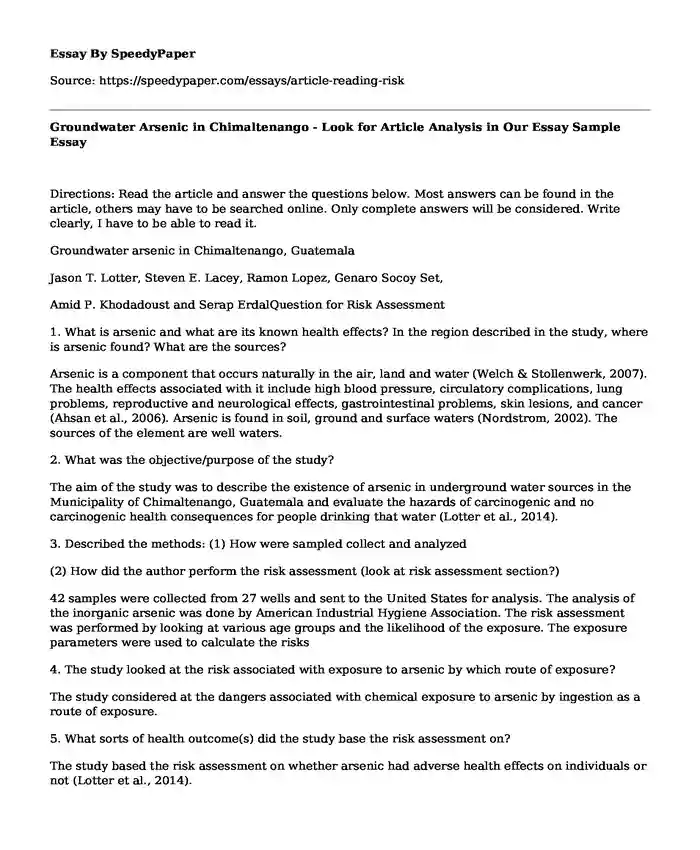
| Type of paper: | Essay |
| Categories: | Environment Water Pollution |
| Pages: | 3 |
| Wordcount: | 747 words |
Directions: Read the article and answer the questions below. Most answers can be found in the article, others may have to be searched online. Only complete answers will be considered. Write clearly, I have to be able to read it.
Groundwater arsenic in Chimaltenango, Guatemala
Jason T. Lotter, Steven E. Lacey, Ramon Lopez, Genaro Socoy Set,
Amid P. Khodadoust and Serap ErdalQuestion for Risk Assessment
1. What is arsenic and what are its known health effects? In the region described in the study, where is arsenic found? What are the sources?
Arsenic is a component that occurs naturally in the air, land and water (Welch & Stollenwerk, 2007). The health effects associated with it include high blood pressure, circulatory complications, lung problems, reproductive and neurological effects, gastrointestinal problems, skin lesions, and cancer (Ahsan et al., 2006). Arsenic is found in soil, ground and surface waters (Nordstrom, 2002). The sources of the element are well waters.
2. What was the objective/purpose of the study?
The aim of the study was to describe the existence of arsenic in underground water sources in the Municipality of Chimaltenango, Guatemala and evaluate the hazards of carcinogenic and no carcinogenic health consequences for people drinking that water (Lotter et al., 2014).
3. Described the methods: (1) How were sampled collect and analyzed
(2) How did the author perform the risk assessment (look at risk assessment section?)
42 samples were collected from 27 wells and sent to the United States for analysis. The analysis of the inorganic arsenic was done by American Industrial Hygiene Association. The risk assessment was performed by looking at various age groups and the likelihood of the exposure. The exposure parameters were used to calculate the risks
4. The study looked at the risk associated with exposure to arsenic by which route of exposure?
The study considered at the dangers associated with chemical exposure to arsenic by ingestion as a route of exposure.
5. What sorts of health outcome(s) did the study base the risk assessment on?
The study based the risk assessment on whether arsenic had adverse health effects on individuals or not (Lotter et al., 2014).
6. What were the findings? (Use bullet points).
Cerro Alto was the site that had high concentrations of arsenic than the WHO provisional guidelines.
The other sites had arsenic concentrations lower than the WHO provisional guidelines (Lotter et al., 2014).
There was a bigger risk of arsenic carcinogenic and no carcinogenic health consequences for inhabitants of Cerro Alto. Nevertheless, no records revealed that arsenic compounds caused skin lesions among the residents of Cerro Alto.
7. What were the limitations of the study?
Sampling was done at east, west, and south of Cerro Alto. The northern part of the area was ignored simply because it did not belong to the municipality of Chimaltenango (Lotter et al., 2014). Secondly, before sample collection, data on well locations which could assist in the sampling strategy was not available. Lastly, Bola de Oro, was not sampled yet it was near Cerro Alto
8. Were any recommendations made for future research?
The recommendations made were to find an alternative source of water that was free from arsenic. Secondly, samples from the north of Cerro Alto and other nearby regions should be collected to provide further evidence for the hypothesis. Thirdly, further examination on the use of arsenic elements in various feed should be done to evaluate the possibility of the source causing the detected arsenic concentration in Cerro Alto water. If the source was found to be the contributing factor different feed that is free from arsenic should be implemented. Finally, to effectively describe the arsenic exposure, extra routes should be included in the health risk assessment (Lotter et al., 2014).
9. Beyond the Study: What environmental factors have been researched that may increase or decrease health outcomes from arsenic exposure?
Dust, soil, and air may increase the health outcomes of arsenic exposure. Besides, ground water also increase health outcomes of the exposure
References
Ahsan, H., Chen, Y., Parvez, F., Zablotska, L., Argos, M., Hussain, I., & Van Geen, A. (2006). Arsenic exposure from drinking water and risk of premalignant skin lesions in Bangladesh: baseline results from the Health Effects of Arsenic Longitudinal Study. American Journal of Epidemiology,163(12), 1138-1148.
Lotter, J. T., Lacey, S. E., Lopez, R., Set, G. S., Khodadoust, A. P., & Erdal, S. (2014). Groundwater arsenic in Chimaltenango, Guatemala: Journal of water and health, 12(3), 533-542
Nordstrom, D. K. (2002). Worldwide occurrences of arsenic in ground water: Science, 296(5576), 2143-2145
Welch, A. H., & Stollenwerk, K. G. (Eds.). (2007). Arsenic in ground water: Springer Science & Business Media.
Cite this page
Groundwater Arsenic in Chimaltenango - Look for Article Analysis in Our Essay Sample. (2019, Nov 04). Retrieved from https://speedypaper.net/essays/article-reading-risk
Request Removal
If you are the original author of this essay and no longer wish to have it published on the SpeedyPaper website, please click below to request its removal:
- Free Essay on Impact and Importance of Technology
- Humans Behaviour Essay Sample
- Essay Sample on Corporate Governance and Board Behaviour
- Varicella Vaccinations, Essay Sample for Free Use
- Conspirator - Movie Review Essay Example
- Free Essay Comprising Patient Interview and Establishing a Diagnosis
- Free Essay: Transitions of Care and the Prevention of Readmissions
Popular categories




